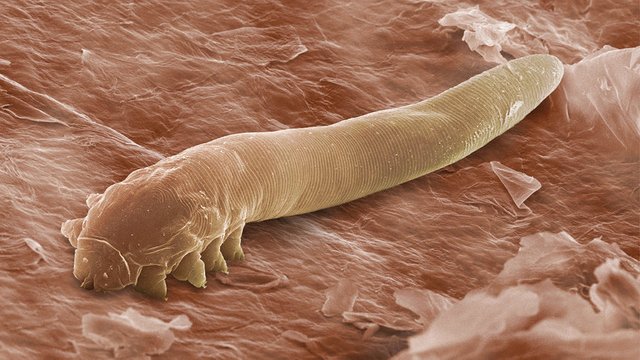
They can easily "hijack" their host's mind and change their course of behaviour.
Although there is no way to know the number of parasites on earth, a study published in 2008 estimates that there are between 75, 000 and 300, 000 different types of parasites that exist on earth. Among these, are 10 parasites that are known to take control over their host’s mind and behaviour, turning them into zombies.
1. GREEN-BANDED BROODSAC (LEUCOCHLORIDIUM PARADOXUM)
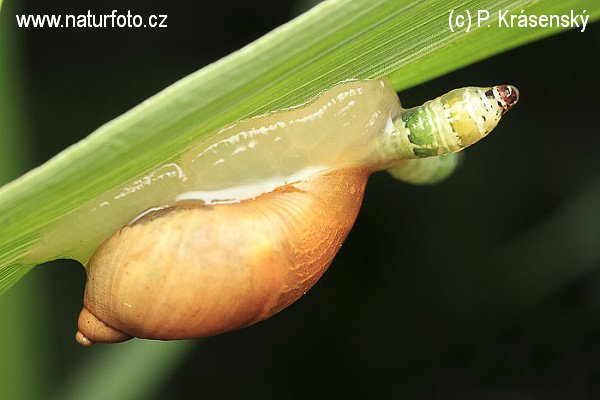
Photo: P. Krasensky
The green-banded broodsac is a parasitic flatworm that finds its way into the eyestalks of a snail, resulting in emerald and olive-green stripes and grey flecks on the tentacles, as well as a maroon tip. The snail’s physical appearance now seems similar to a succulent, colourful caterpillar, which is bird’s prey.
Once the snail is eaten by the bird, the worm is able to reproduce by controlling the snail’s behaviour. According to a 2013 study by Wanda Wesolowska and Tomasz Weslowski of Wroclaw University in Poland, infected snails placed themselves higher in the vegetation, in brightly-lit and more exposed areas. This makes them easier prey for birds and increases their chances of being eaten.
2. ZOMBIE ANT FUNGUS (OPHIOCORDYCEPS UNILATERALIS)

Photo: Reddit
The Ophiocordyceps unilateralis, a parasitic fungus, mainly infects Camponotus leonardi ants found in the rainforests of Thailand, Africa and Brazil. A spore first infects an ant on the rainforest floor, and develops in its body over a period of 3 to 9 days. When the fungus is nearing the last stage of its cycle, it begins manipulating the ant.
Ants are able to navigate their way to food, often picking the most efficient route. However, once infected, the ant loses control of its body, moving away from safety instead. A study in 2009 found that infected ants often ended up going towards similar spots – approximately 25cm up a tree, where the environment is conducive for the growth of fungus. The ant then bites on a leaf using its mandibles and dies.
Within a day, fungal threads appear from the corpse. Eventually, a stalk emerges from the ant and scatters spores onto the rainforest floor for more ants to be infected.
3. CASTRATOR BARNACLES (SACCULINA SP.)
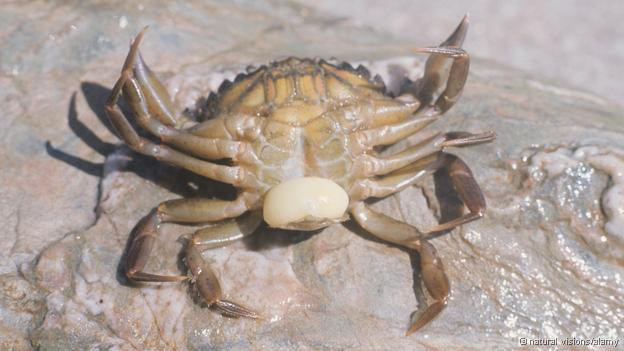
Photo: Pinterest
A Sacculina barnacle forces the host crab to care for its larvae. It does so by entering a crab through a crevice in its claw joints, shedding its tough shell as it squeezes its way in. The barnacle ends up bearing more resemblance to a slug than a regular barnacle.
The barnacle then uses the crab’s nutrients to reproduce, with its fully grown form looking similar to an egg yolk. A study published in 2012 found that for male crabs, the barnacle feminises it to support the Sacculina larvae. The male crab becomes impotent, its gonads (sex organis) shrink, its fighting claws stop growing, and its abdomen expands instead to carry the barnacle’s offspring.
4. KAMIKAZE HORSEHAIR WORM (PARAGORDIUS TRICUSPIDATUS)
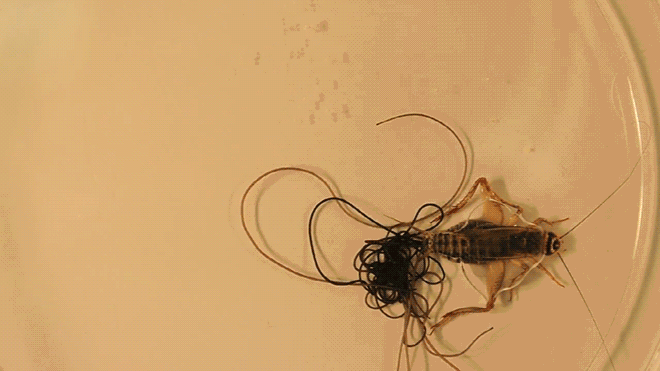
GIF: Wired
A horsehair worm larva is first eaten by the larva of other insects such as mosquitoes and mayflies. A cricket or grasshopper will then devour it as soon as it surfaces from the water. The horsehair worm starts growing inside the cricket.
However, for the worm to be completely grown, the cricket has to be in water, beyond its natural habitat. This is where the mind manipulation begins, as a journal published in 2003 discovered that the worm changes the functions of the cricket’s central nervous system, to force it dive into the nearest aquatic environment. The cricket essentially drowns itself, and the horsehair worm surfaces to reproduce.
The fully grown worm can be as long as 30 cm, and resembles a cooked strand of spaghetti. While the cricket may appear to have dived into the water of its own accord, it has actually been controlled neurologically by the worm. Ben Hanelt from the University of New Mexico in Albuquerque, who studies the worms, told BBC that he has witnessed 32 worms emerging from an unlucky host.
5. EMERALD COCKROACH WASP (AMPULEX COMPRESSA)
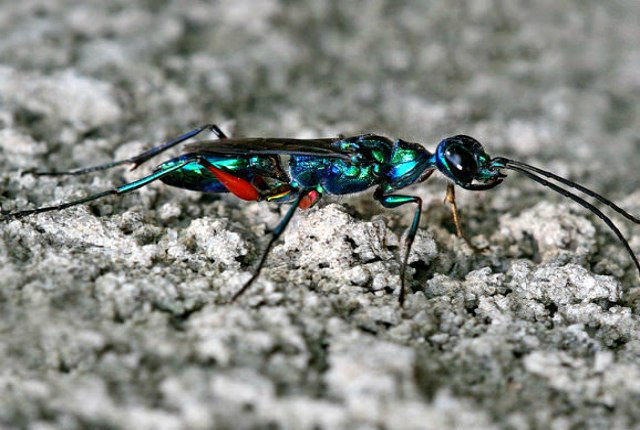
Photo: Mr. Roboto
The emerald cockroach wasp can be found in the tropical regions of Asia, Africa and the Pacific islands. It has a metallic body that glows emerald, bright crimson markings on two of its legs, and is one-sixth the size of a roach. However size is not an issue for the emerald cockroach wasp, as takes over the roach’s mind by stinging it, leaving it immobilised. According to an investigation published in 2010, a concoction of neurotransmitters is then sent to the brain, turning the roach into its avatar.
The wasp then feeds on the roach’s blood, chewing off its antannae and guiding it to its nest. The wasp then lays its eggs on the roach’s abdomen, and prevents its escape by barricading the nest with pebbles. While the roach could escape, it remains motionless, allowing the wasp larva to consume it alive.
Eventually, an adult wasp emerges from the roach’s remains.
6. LADYBIRD PARASITE (DINOCAMPUS COCCINELLAE)
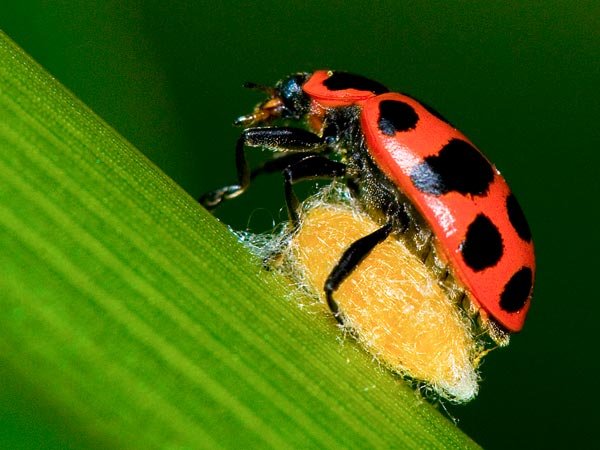
Photo: National Geographic
The Dinocampus coccinellae is a wasp whose eggs need protection from predators. The ladybird becomes an ideal host, as the bright colours on its back are a warning sign to deter predators. Ladybirds are also capable of emitting poison when provoked.
However, the parasitic wasp can get through these, laying an egg with one sting. After hatching from the egg, the larva bites its way through the internal tissues of the ladybird, emerging from the abdomen and spinning a cocoon between its legs. The ladybird is now involuntarily protecting the cocoon. Despite the injuries, the ladybird remains alive. In a 2011 study, 25% of the infected ladybird survives. It is able to jerk its body to throw off predators. While the reason for this remains unknown, there is speculation that this is a result of the venom left by the larva.
7. SCHISTOCEPHALUS SOLIDUS
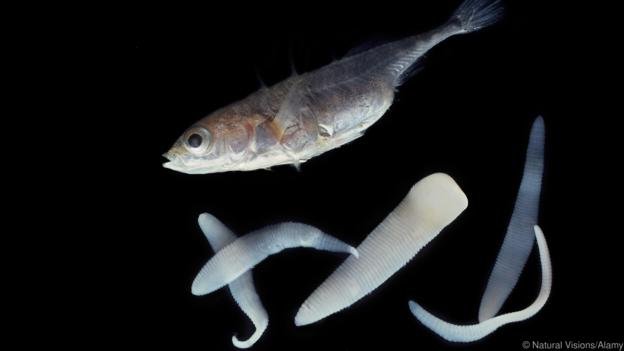
Photo: Natural Visions Alamy
In certain cases, a host can be carrying more than one parasite. These parasites may have conflicting agendas, and they would have to fight for control of the host. Commonly, it is when one parasite is ready to progress to another host, but the other is not.
Nina Hafer and Manfred Milinski from the Max Planck Institute of Evolutionary Biology in Ploen, Germany investigated this phenomenon by infecting small crustaceans called copepods (Macrocyclops albidus) with a few tapeworms (Schistocephalus solidus). As these tapeworms eventually need to move on to a stickleback, which is a fish host, they do so by altering the copepod’s behaviour. The copepod becomes more energetic, making it an easy prey for the stickleback.
It was found that if both tapeworms had the same objective, their effect on the host was multiplied, suggesting that the tapeworms were working together. In cases where there was a conflict of objectives, the host copepod still became more active. Hafer and Milinski both contend that the older tapeworm that was ready to move on to a new host destroyed its younger rival.
8. TOXOPLASMOSIS (TOXOPLASMA GONDII)
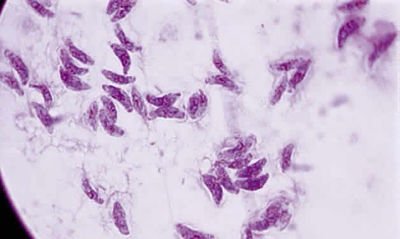
Photo: Oculist.net
As this parasite needs for its host to be eaten by a cat in order to reproduce, it mainly infects mice and rats. According to a 2007 study, infected mice and rats no longer fear the smell of cats. On the other hand, they get pulled towards a pheromone in the cats’ urine. The likelihood of the infected host sniffing around cats increases together with its chance of getting eaten, and the parasite achieves its goal.
However, T. gondii can infect humans as well. While there are approximately 30 to 60% of people infected by this parasite, there has yet to be conclusive research on whether it affects the human behaviour.
Interestingly, toxoplasmosis is also frequent in schizophrenia cases. A study in 2003 concluded that humans with a severe T. gondii infection can produce psychotic symptoms mimicking schizophrenia. However, further research is needed to prove if there is a cause and effect relationship between the two.
9. RABIES VIRUSES
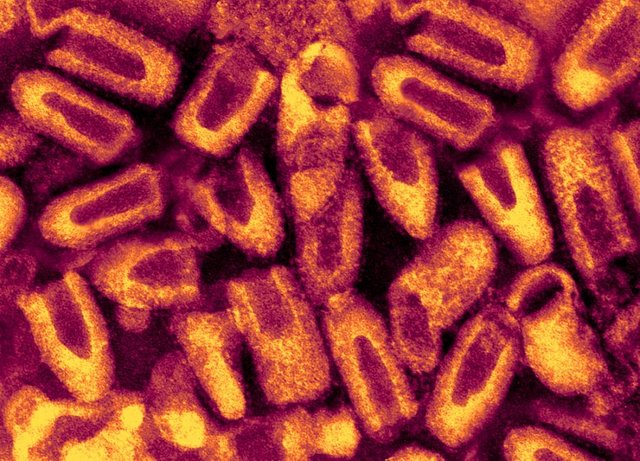
Photo: Pinterest
Rabies viruses are parasites as they “generally reduce the fitness of their host, or benefit at the expense of their host”, according to Levi Morran of Emory University in Atlanta, Georgia. They virus is transmitted through saliva, often from a bite or a scratch. While the common hosts are dogs and bats, humans have been infected as well. Those infected often become more aggressive, having a higher chance of spreading the virus through scratching or biting.
Parasite expert Andres Gomez of ICF International in Washington, DC, explains that “rabies manifests itself with a wide range of neurological signs, including changes in behaviour but also loss of motor control. The latter sometimes include difficulties with swallowing that eventually lead to hunger, hypoglycaemia, and dehydration.”
There is also a myth that those infected with the rabies virus develop a fear of water, but Gomez has refuted this. “Patients have involuntary spasms when trying to drink and later when presented with water. But it’s not fear,” Gomez told the BBC.
10. INFLUENZA VIRUS

Photo: How Stuff Works
The flu virus makes infected people more sociable, according to a 2010 study by Chris Reiber and her colleagues of Binghamton University in New York. Although the study was a minor one, Reiber’s team discovered that those infected had a higher chance of going out to bars and parties, which enables the flu virus to be spread to even more people.
very interesting and informative, :) can you please view and comment on one of my posts thanks in advance.
Downvoting a post can decrease pending rewards and make it less visible. Common reasons:
Submit
Very Interesting. Toxoplasmosis - totally explains the "cat lady."
Downvoting a post can decrease pending rewards and make it less visible. Common reasons:
Submit